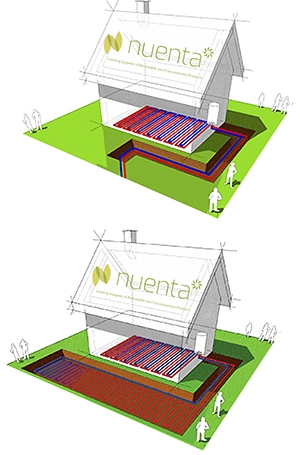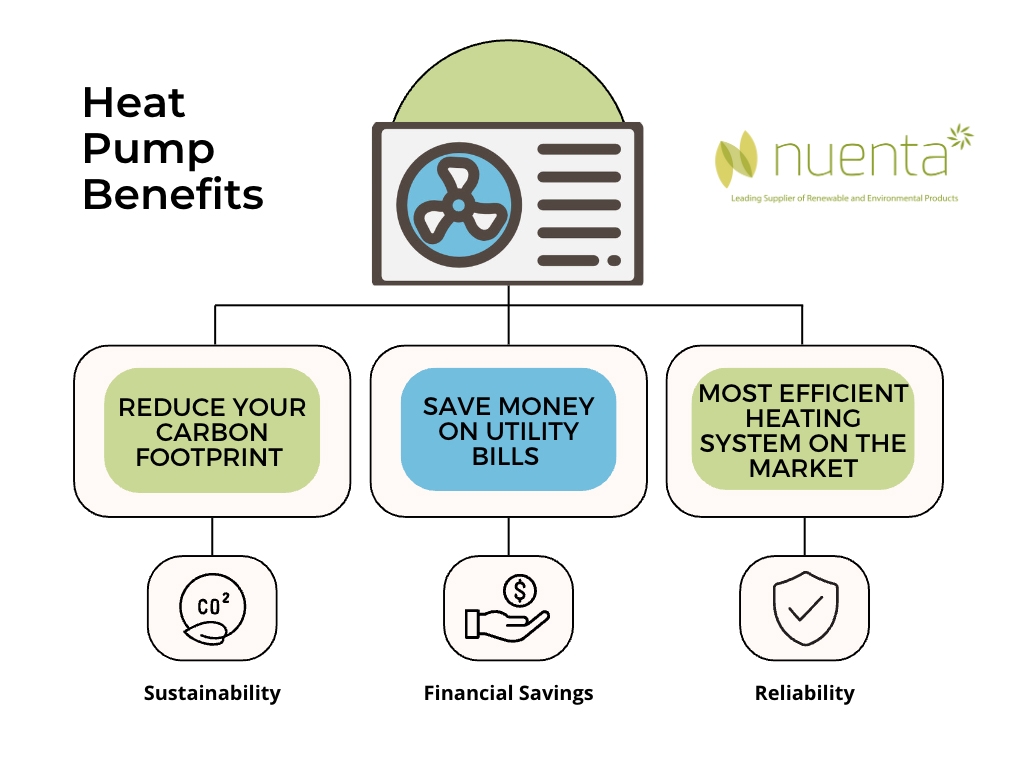Learning Hub
Renewable heating systems are fuelled by sustainable sources, delivering a reliable and constant stream of power to your property.
Traditional heating is an increasingly inefficient and expensive method of supplying heating and cooling to your home or business. Currently, gas is the number one fuel choice delivered in the UK, championing electric, oil and LPG.
Yet, times are changing. With government grants and incentives backing the rise of renewable heating, it’s a matter of time before gas falls and renewables triumph. The UK wouldn’t be the first to see this happen either. Across the waters and into areas of Europe, like Germany, heat pumps have overshadowed gas as the most popular domestic heating system.
New technologies cease to surprise people these days. This makes sense, given how quickly tech has evolved. Then why would the decarbonisation of heating be such a shock?
Renewable heat reduces your utility bills and your carbon footprint. There are plenty of heating solutions to learn about and choose from, with options designed specifically for residential and commercial establishments.
Here at Nuenta, we’re proud to stand alongside Ecoforest and its range of ground and air-sourced heat pumps. As we’re their chosen, sole UK distributor, we’d be selling ourselves short if we simply said we know our stuff.

What Is a Heat Pump?
The basic principles of both ground source and air source heat pumps are the same. They’re an efficient way to provide hot water and heating to your home. Heat pumps absorb heat from all around us, whether that be the heat that sits beneath us underground or heat energy in our air.
The heat energy is transferred to a fluid. The technology increases the temperature even further by upping the pressure. The key difference is clear in their namesake. Air source heat pumps absorb heat from our air, whereas ground source heat pumps absorb heat from underground.
Check out our info guides below for more information…
Ground Source Air Source
Ground Source Vs Air Source
There are plenty of factors to consider as you weigh what best fits your needs. While weighing up the efficiency differences, the installation costs and space requirements, you’re probably thinking of how practical of a change this will be for you too.
That’s why we’ve collated all the information you could need to help you decide. The two championing types of heat pumps are, of course, the ground source and air source units.
The Cost
Although the two technologies are similar in their fundamental principles, installation costs differ. Cost factors to consider include:
- The condition of your home, whether you live in a newer or older property. The general rule of thumb is that the costs will likely be less if you live in a new building.
- The size of your home, which affects the size of the unit you need.
- The scale of preparation work required to install either unit. You may need to install additional electrical supplies dependent on the location of your heat pump.
- Whether your radiators need upgrading so you get the most out of your unit.
Air source heat pumps are typically less expensive than ground sources. Air source heat pumps in today’s market range from £7,000 to £13,000.
£14,000 to £19,000 is typical for ground source heat pumps. Installation costs here are more expensive too. The additional charges come from the installation process. For the system to retrieve heat from underground, there must be access. You would then need to install boreholes or slinkies in your garden.
There are always pros and cons. An air source heat pump is likely more straightforward and cheaper at face value. Ground source units are more efficient in heating your home. So, despite the higher upfront fees, you are guaranteed to save more on your utility bills in the long run.
Efficiency
The colder the starting temperature, whether underground or in our air, the more energy a heat pump requires to escalate the starting temperature. With that in mind, when considering efficiency, it’s important to note where you live and the weather conditions you encounter will have an effect.
Typical temperatures in the UK range from lows of -5 to 25oC. Underground temperatures are unlikely to reach highs of 25oC, yet also unlikely to reach lows of -5oC. We know then that the colder the weather is, the more efficient the ground source heat pumps will be, with the air source being less so.
As a general statement, the further North you live, the better suited you are in choosing a ground source unit. And vice versa if you live in the south.
Ground Source Installation
As long as the ground is suitable for digging, you could have a vertical or horizontal ground loop, arguably the most common installation technique. Vertical pipework is better known as a borehole and generally becomes more expensive. Houses on the smaller side may only need one borehole installed. However, the bigger your property, the more boreholes you'll need.
Horizontal pipework is less expensive, but you may be restricted in choosing this option as your garden needs to be a sufficient size. Of course, each installation is unique, just like the many types of properties in the UK. But, as a general observation, you need 2.5-3 times the land than the floor space of your home.
For instance, say your home is 150 m2, and the land you need for vertical boreholes will range from 400-450 m2. It's important to note, too, that there can't be any obstructions like tree roots and the like within that area.
The unit also needs a safe storage area, and they're about the size of a large fridge. Some models require the installation of an integrated hot water cylinder also.
Several weeks later, the installation process is complete. Your garden's aesthetic will remain the same, and you'd have no idea the heat pump existed if you weren't already aware.

Air Source Installation
The installation process will take less time than ground source units. There's no reason to dig up the land, either. Visually, air source heat pumps look similar to air conditioning units, probably because they are mounted outside a property.
The specific size of the model you need entirely depends on the size of your home and how high a heat demand exists already. Installers are on hand with advice during the entire process.
Unlike GSHPs, this unit will be visible. It's important to note that they generate noise when the system runs. You and your installer are advised to consider if the noise will affect any neighbours. Not that they're significantly loud. They're relatively quiet. For reference, you can hold and hear a casual conversation and only be a couple of meters away.
What’s best for you?
The typical advantages and disadvantages for both are very similar, saving you money in steering your energy source away from gas and reducing your carbon footprint. We recommend that you talk to people such as ourselves at Nuenta and trusted installers to support your decision-making process.
Heat Pump Benefits

Reduce Your Energy Bills
The prices of gas and oil are astronomical at the moment. Moving to a heat pump will make your traditional boiler useless. If you don’t require gas to run any appliances in your home, you could be free from needing gas altogether. Furthermore, if you have a solar panel array installed in your home, you could use the energy the PV system harvests to power the heat pump. Your heating requirements are then fully independent of the grid.
Clamp Down on Your Carbon Footprint
EDF have found that you could reduce carbon emissions by over 23 tonnes of CO2 over 10 years.
Be a Part of the Future
It’s a matter of time before the UK catch up with the rest of Europe to implant heat pumps as a reliable alternative to boilers. In Norway, over a third of residents use heat pumps which now account for 95% of new heating.
Excellent Efficiency
There’s no competition between heat pumps and traditional heating sources like gas boilers. Heat pumps have an average efficiency rating of 300 – 400%, whereas boilers typically reach a mere 90% efficiency.
Frequently Asked Questions
The more inefficient your current system is, like if you have a G-rated LPG boiler, the more money you will save. This is how you can calculate your average savings –
First, calculate your gas consumption for space and water heating only. Let’s say the average is 12,000 kWh per annum, costing £0.10/kWh. Now we know you’re spending £1,200 annually.
Now to figure out your heat pump running costs, you’ve got to calculate your heat demand. Your current annual gas consumption and boiler efficiency will help here. For this calculation, we’ll assume your boiler is 85% efficient (a relatively new boiler). If gas consumption is 12,000kWh and 85% turned into heat, your heat demand is 10,200kWh. (12,000 x 0.85).
Generally speaking, heat pumps have an efficiency of 300%. For the heat pump to deliver 10,200kWh as the heat demand, the electricity required should be 3,400kWh. (10,200 / 3). Now let’s say it costs £0.3 per kWh. Your annual spending would be £1,020, saving you £180.
It’s important to note that the cost of energy fluctuates all of the time, but you can use the same calculations with your data from home.
The refrigerant within the heat pump is able to absorb heat even at low temperatures. Heat pumps are proven to work in cold climates. Norway has colder weather than the UK on average, and they’re currently front lining the race to install heat pumps on a mass scale.
We recommend that you opt for an installer who specialises in heat pumps. Not all plumbers will be familiar with the kit, which does look different to what they usually work with. However, that’s not to say a plumber hasn’t received specialist training to grow their business.
One of the great things about heat pumps, is that they tend to need very little TLC. As long as the system has been installed correctly, and the unit is kept clean, the heat pump should keep going without cause for concern.